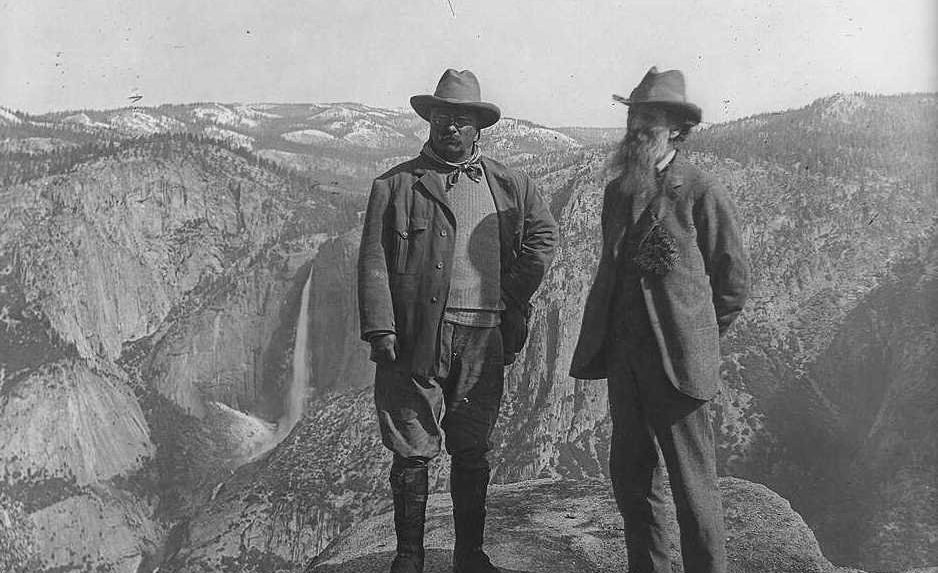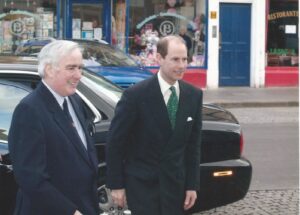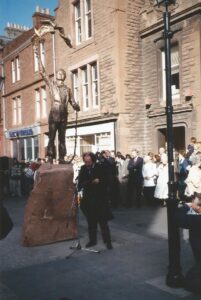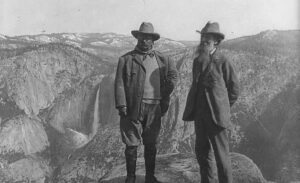Main Picture Credit: John Muir and Theodore Roosevelt, 1903. Library of Congress
John Muir was born in Dunbar on 21st April 1838. The family emigrated to America in 1849. He married Louisa Wanda Strentzel in 1880 and lived in Martinez. The Yosemite national park was established in 1890. He came back to Dunbar in 1893 and stayed with relatives. He died on 24th December 1914.
When I came to Dunbar in 1966 little was known about John Muir though an exhibition had been organised earlier that year, which included a section on Muir. It showed a collection of first Day Covers of an American stamp featuring him, issued in 1964 which had been sent to Dunbar Post Office. The then Headmaster of Dunbar Grammar School was another John Muir, and this caused some confusion when people asked about John Muir. The Community Council, which was created in 1976, has identified with John Muir projects since that time.
In 1966 Bill and Mamie Kimes came to Dunbar to find Muir’s birthplace They were Muir bibliographers and sold the idea of Muir to Frank Tyndall the county planning officer*. He decided to confirm Muir’s importance and went to California. He decided to repatriate this son of Dunbar.
An exhibition was held in the National Library in the setting up of which Frank Tindall, played a key role. The National Library also acquired Muir’s books. The country park was being established in 1976 and Ian Fullerton suggested it should be called the John Muir Country Park and this was done.
The John Muir House was restored, and a small museum established in1980. This was a joint venture between the Council and Mrs D Hawrluk. The top floor of the building was made into a small museum. Ian Gardner, who was then eleven years old and a pupil at Dunbar Primary School became the voice of John Muir in the audio-visual presentation which was a feature there.
In 1980 discussions were held about possible links between Martinez and Dunbar and in March 1981 Martinez declared that Dunbar was to have Sister City status. Discussions were held and a reciprocal declaration was made. Visits were made by individuals from both communities Mrs Lorraine Laird came from Martinez and presented a picture to Dunbar and Molly Keith the secretary of the Community Council and Elizabeth Taylor went to Martinez. A school exchange scheme was set up and, and several valuable exchanges took place, including one by my own son in 1988. These visits were three weeks each way, i.e. six weeks in one summer, which I think some youngsters found challenging as was the long solo journey. Allan Forrest, a local boy, climbed Half Dome in 1989. The pictures taken on his expedition were awesome.
East Lothian Council, the Dunbar Initiative and the John Muir Trust combined to celebrate Muir’s 150th birthday in 1988. A ceremony was held in Dunbar Town House attended by Lawrence Downing, President of the Sierra Club, at which Sir Kenneth Alexander, chairman, of the John Muir Trust, announced that H.R.H. The Prince of Wales had agreed to be the Royal Patron of The John Muir Trust. School children, dressed in Victorian costume, posted letters in the old post box adjacent to the birthplace, to Heads of State around the world in which they stressed the importance of John Muir and asked the Leaders about their intentions for conservation throughout the world. This effort elicited an amazing number of responses. A reception was held in the John Muir country Park and children planted trees there. I gave a talk on John Muir in Dunbar Library in the evening.
In 1992 East Lothian District Council launched an ambitious proposal to establish a centre to be called The John Muir Environmental World at Linkfield car park. It raised a lot of opposition from various groups and individuals. E.L.D.C. announced in Feb 1994 that it had withdrawn its planning application for this proposal. In March a meeting was held to consider the possibility of establishing a John Muir Centre in Dunbar. The John Muir Trust identified itself very closely with this proposal, which had the stated aim of celebrating John Muir’s life and serving as a showcase for all that is best in the natural environment of East Lothian and Scotland. During 1994/5 this idea was taken forward. Initially plans were considered to develop the former garage of the George Hotel in Lamer St. At that stage there was no support from L.E.E.L. or the District Council.
In 1995 there was an indication that the birthplace was coming on the market and Lawrence Downing suggested that it should be purchased as a base for the DJMA. The main thrust at this stage was still the development of a centre.in another location. The idea of two properties raised problems. LEEL and the new unitary authority (which came into existence in April 1996) did involve themselves at this stage, in a new project and Sir James Dunbar-Naysmith developed a proposal to use the A.C.F. building which overlooks the sea. The suggested theme was Wild Rock, Sea and Sky. The centre project was abandoned when the Seabird Centre in North Berwick was confirmed as the approved millennium project for the area.
At this stage the idea of purchasing the birthplace became the local priority. The small museum had become a popular attraction, but the building now came up for sale. In 1998 The John Muir Birthplace Trust was set up. An appeal was launched to raise money to buy the house. On 29th Jan 1999 ownership of John Muir’s birthplace officially passed to the JMBT. Proposals to develop the building were invited. On 31ST January 2001 the trustees invited a leet of three firms to make submissions. The three chosen were, Simpson & Brown, architects, Benjamin Tindall and Campbell & co. After much thought and discussion Campbell & Co were selected.
At their presentation it was intimated that the distinguished architect Richard Murphy would be the architect for the project. The trustees met with Campbell &Co on 24th May 2001 and a presentation was made outlining their proposals. The Trustees lodged a planning application which was registered on 12th June 2001. It was hoped the project would be completed for 21 April 2002. (John Muir’s Birthday).
There was still a view in Dunbar that it might be desirable to retain a traditional museum and also have a modern centre. There was a large-scale media campaign which indicated the value and also the dangers of modern communications. Eventually consent was granted, and the project was complete by August 2003. In October 1997 the statue carved by Valentin Znoba was unveiled in front of Dunbar Town House by Magnus Magnusson, then chair of SNH. On 27th Feb 2008, as a Depute Lieutenant of East Lothian, I received HRH the Earl of Wessex on a visit to the Birthplace. A visit was made by HRH The Prince of Wales on 4th June 2009.
Other developments.
In 1996 the John Muir Trust set up a John Muir Award. The first group of children to receive the award was from Dunbar Primary School. They received the award from the American consul Julie Moyes at a ceremony at Dunbar Leisure centre.
There was a large Exhibition in Edinburgh City Art Centre in 1999 which was easily accessible from Dunbar as the centre is adjacent to Waverley Station.
Dunbar Community Council concluded a Sister City arrangement with Haines, Alaska. This was proclaimed in Haines on 16th Dec 1998 and in Dunbar on 18th of January 1999.
On 28th of January 2000 a similar resolution was passed by the councils in the watershed of the valley of the Bighead River [St Vincent Township, Sydenham Township, and the town of Meaford]. Dunbar Community Council signed a reciprocal agreement on John Muir’s birthday 21st April 2000. That day also marked the opening of the Millennium Exhibition ‘An Infinite storm of Beauty’ in the John Muir Birthplace and Dunbar Parish Church. John Muir was declared, The man of the Millennium in East Lothian and in Dunbar.
In 2008 David Anderson published a Town Trail, entitled ‘John Muir’s Dunbar’, which follows a route round buildings identified with Muir.
The new council H.Q in Haddington was called John Muir House and a new Coastal Walkway in East Lothian was called John Muir Way.
A further sister city agreement was concluded with Marquette County in Wisconsin on 31st May 2013.
On 21st April 2014 the John Muir Way from Dunbar to Helensburgh was opened by Alex. Salmond, the First Minister of Scotland. It incorporated part of the previous East Lothian way.
A Flagstone commemorating John Muir was unveiled at Makar’s Court in Edinburgh on 29th April 2014.
The section of the East Lothian way from Dunbar to Cockburnspath is now called the John Muir link and provides links to the Berwickshire Coastal way and to the Southern Upland way.
The centenary of John Muir’s death on 24th December 2014 was recognised in Dunbar and the Community Council sent appropriate messages to the communities with whom we had established links.
An important two-day visit took place in Dunbar in May 2015 when a group of six members of the John Muir Association board of directors and four partners visited Dunbar and information was exchanged and useful contacts were made with Dunbar delegates.
An important part is played by the Friends of John Muir’s Birthplace [formerly the Dunbar John Muir Association]. The group was very active in raising awareness locally from 1994 and continues to support the work of the Birthplace with exhibitions, events and talks. It also provides volunteers to man the Birthplace and other activities.
The Birthplace has become an award-winning attraction. It reached its 200, 000 visitor on 4th March 2020 with a group from Cherry Trees Nursery in Dunbar. In spring of 2019 it was awarded a fifth ‘Visit Scotland award’ and in the summer of 2019 a ‘Trip Advisers certificate of excellence’.
This is a truly wonderful success story.
Stephen Bunyan 10 / 07/ 20
*Frank Tindall was County Planning officer from 1950-1975, Director of Physical Planning with Lothian Regional Council from 1975-1983, Director of the Lothian Building Preservation Trust 1983-1996.
Further reading
John Muir, My Boyhood and Youth 1913
Frank Tindall, Memoirs &Confessions of a County Planning Officer 1998 p 251
4th Statistical Account of East Lothian, Vol six p 97
Friends of John Muir’s Birthplace ‘Wee Books’
A Town Trail, John Muir’s Dunbar. David Anderson, 2nd Edition 2008
Still Walking the World, Quotations from the writings of John Muir. Will Collin, 2007
John Muir, Close to Nature’s Beating Heart. Will Collin 2008
A Scotchman Comes Home, John Muir’s Homecoming. Will Collin, 2009
Walking the East Lothian John Muir Way. Robert Russel, 2nd edition 2015 All £3.50
John Muir Clifftop Trail 2002 £2.50




